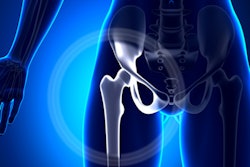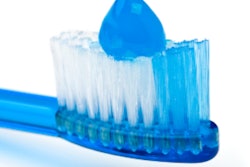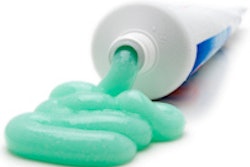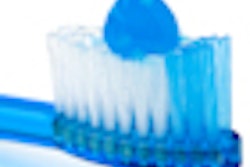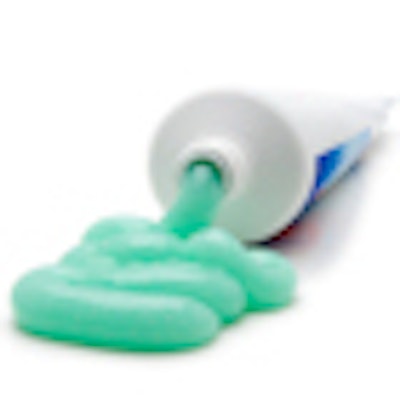
Triclosan, an antibacterial chemical commonly used in toothpaste, mouthwash, hand soaps, and other personal care products, has been found to hinder muscle contractions at a cellular level, according to a new study in the Proceedings of the National Academy of Sciences (August 13, 2012).
Researchers from the University of California (UC) at Davis and the University of Colorado performed several experiments to evaluate the effects of triclosan on muscle activity, using doses similar to those that people and animals may be exposed to every day.
In "test tube" experiments, the team evaluated the effects of triclosan on molecular channels in muscle cells that control the flow of calcium ions, creating muscle contractions. The researchers found that triclosan impaired the ability of isolated heart muscle cells and skeletal muscle fibers to contract.
Normally, electrical stimulation of isolated muscle fibers under experimental conditions evokes a muscle contraction, a phenomenon known as "excitation-contraction coupling." But in the presence of triclosan, the normal communication between two proteins that function as calcium channels was impaired, causing skeletal and cardiac muscle failure.
The researchers also found that triclosan impaired heart and skeletal muscle contractility in living animals. Anesthetized mice had up to a 25% reduction in heart function measures within 20 minutes of exposure to the chemical, they reported.
"The effects of triclosan on cardiac function were really dramatic," said study co-author Nipavan Chiamvimonvat, MD, a professor of cardiovascular medicine at UC Davis. "Although triclosan is not regulated as a drug, this compound acts like a potent cardiac depressant in our models."
In addition, the mice had an 18% reduction in grip strength for up to 60 minutes after being given a single dose of triclosan. Grip strength is a widely used measure of mouse limb strength, employed to investigate the effects of drugs and neuromuscular disorders.
More research needed
The investigators also examined the effects of triclosan exposure on fathead minnows, a small fish commonly used as a model organism for studying the potential impact of aquatic pollutants. Those exposed to triclosan in the water for seven days had significantly reduced swimming activity compared with controls during both normal swimming and swim tests designed to imitate fish being threatened by a predator.
"We were surprised by the large degree to which muscle activity was impaired in very different organisms and in both cardiac and skeletal muscle," said study co-author Bruce Hammock, PhD, a professor in the UC Davis Department of Entomology.
The UC Davis research team has previously linked triclosan to other potentially harmful health effects, including disruption of reproductive hormone activity and cell signaling in the brain.
Dr. Chiamvimonvat cautioned that translating results from animal models to humans is a large step and would require further study. However, the fact that the effects were so striking in several animal models under different experimental conditions provides strong evidence that triclosan could have effects on animal and human health at current levels of exposure.
Although triclosan was first developed to prevent bacterial infections in hospitals, its use has become widespread in antibacterial products used in the home. However, according to the U.S. Food and Drug Administration (FDA), other than its use in some toothpastes to prevent gingivitis, there is no evidence that triclosan provides other health benefits or that antibacterial soaps and body washes are more effective than regular soap and water. Experts also express concern about the possibility of resistant bacterial strains developing with the overuse of antibacterial products.
Because the chemical structure of triclosan resembles other toxic chemicals that persist in the environment, the FDA and the U.S. Environmental Protection Agency are conducting new risk assessments of the chemical. Based on their study outcomes, the researchers argue that the potential health risks call for greater restrictions.
"Triclosan can be useful in some instances; however, it has become a ubiquitous 'value added' marketing factor that actually could be more harmful than helpful," Hammond said. "At the very least, our findings call for a dramatic reduction in its use."
Some experts took issue with the study and its findings, however.
"Whilst this research is of interest to scientists, it would be totally wrong to extrapolate to humans or wider environmental concerns because these experts were working with extremely high levels of triclosan," said Tony Dayan, MD, emeritus professor of toxicology, University of London, in a statement published on the Science Media Centre website. "The authors report a sophisticated study of electrophysiological and ion flux across membranes. The effects they demonstrate under their experimental conditions are very likely to be correct and valid for their experiment, which is the key point."
Almost all their work is based on huge doses of triclosan given directly into the body through intraperitoneal injection or into the test system in vitro, Dr. Dayan noted.
"The concentrations will be far in excess of anything ever achieved in humans or animals that are exposed to triclosan by the conventional routes of oral or dermal exposure, such as from toothpaste, deodorants, socks, or nappies," he said. "The results found here depend on concentrations that are 50 to several hundredfold greater than those which were shown to have no harm to muscles of humans or lab animals."




